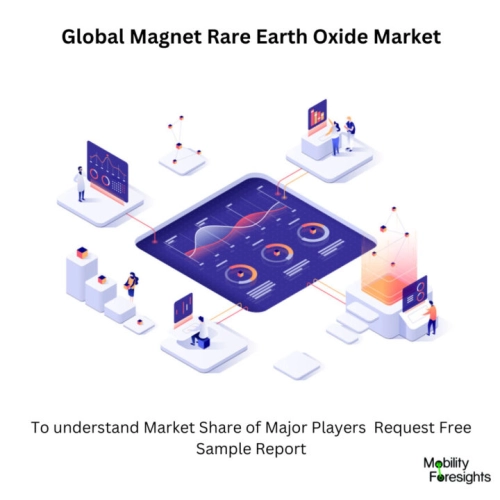
- Get in Touch with Us

Last Updated: Apr 25, 2025 | Study Period: 2024-2030
An assortment of chemical compounds with rare earth element content and magnetic characteristics are referred to as magnet rare earth oxide.
Lanthanum, cerium, neodymium, samarium, europium, and gadolinium are only a few of the 17 metallic elements that make up the rare earth series. These substances are collectively referred to as "rare earths" since the Earth's crust contains very few of them.
Strong permanent magnets, often known as rare earth magnets, are made with the help of magnet rare earth oxides. These magnets have a high coercivity, magnetic characteristics, and extraordinary strength.
Due to their capacity to produce powerful magnetic fields in very tiny areas, they have transformed a number of sectors, including electronics, automotive, renewable energy, and medical devices.
The rare earth oxides neodymium oxide (Nd2O3), dysprosium oxide (Dy2O3), and samarium oxide (Sm2O3) are most frequently utilized in the manufacture of magnets. Because it serves as the foundation for neodymium-based magnets, the strongest permanent magnets currently on the market, neodymium oxide is particularly significant.
Common chemical methods used to create magnet rare earth oxides include precipitation, hydrothermal reactions, and thermal breakdown. These procedures entail the removal of rare earth elements from ore deposits, refinement, and conversion of the elements into oxides.
When making rare earth magnets, the resultant rare earth oxides are employed as the primary raw materials. Many different technologies, including computer hard drives, MRI scanners, electric motors, generators, headphones, and speakers, have found extensive use for these magnets.

The Magnet Rare Earth Oxide accounted for $XX Billion in 2023 and is anticipated to reach $XX Billion by 2030, registering a CAGR of XX% from 2024 to 2030.
Shin-Etsu Chemical Co., Ltd. is only one of the businesses that produce Dysprosium Oxide (Dy2O3), an important rare earth oxide. In many different fields and applications, Dy2O3 is extremely important due to its special features.
The creation of high-performance magnets, particularly those based on neodymium, is one of dysprosium oxide's main uses. The remarkable magnetic strength of neodymium magnets, sometimes referred to as NdFeB magnets, is well recognized.
To improve their thermal stability and stop demagnetization at high temperatures, dysprosium is added to neodymium magnets. This is particularly crucial in difficult situations where magnets are exposed to high temperatures, such as electric car motors, wind turbines, and other applications.
A higher Curie temperature and better coercivity can be achieved when Dysprosium oxide is added to the manufacturing process.
| Sl no | Topic |
| 1 | Market Segmentation |
| 2 | Scope of the report |
| 3 | Abbreviations |
| 4 | Research Methodology |
| 5 | Executive Summary |
| 6 | Introdauction |
| 7 | Insights from Industry stakeholders |
| 8 | Cost breakdown of Product by sub-components and average profit margin |
| 9 | Disruptive innovation in theIndustry |
| 10 | Technology trends in the Industry |
| 11 | Consumer trends in the industry |
| 12 | Recent Production Milestones |
| 13 | Component Manufacturing in US, EU and China |
| 14 | COVID-19 impact on overall market |
| 15 | COVID-19 impact on Production of components |
| 16 | COVID-19 impact on Point of sale |
| 17 | Market Segmentation, Dynamics and Forecast by Geography, 2024-2030 |
| 18 | Market Segmentation, Dynamics and Forecast by Product Type, 2024-2030 |
| 19 | Market Segmentation, Dynamics and Forecast by Application, 2024-2030 |
| 20 | Market Segmentation, Dynamics and Forecast by End use, 2024-2030 |
| 21 | Product installation rate by OEM, 2023 |
| 22 | Incline/Decline in Average B-2-B selling price in past 5 years |
| 23 | Competition from substitute products |
| 24 | Gross margin and average profitability of suppliers |
| 25 | New product development in past 12 months |
| 26 | M&A in past 12 months |
| 27 | Growth strategy of leading players |
| 28 | Market share of vendors, 2023 |
| 29 | Company Profiles |
| 30 | Unmet needs and opportunity for new suppliers |
| 31 | Conclusion |
| 32 | Appendix |